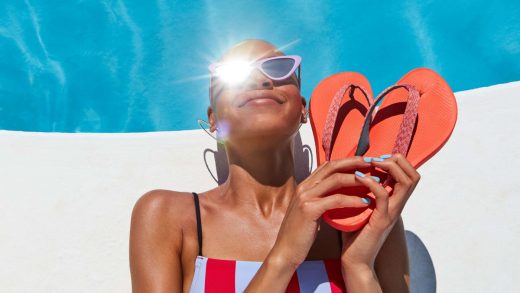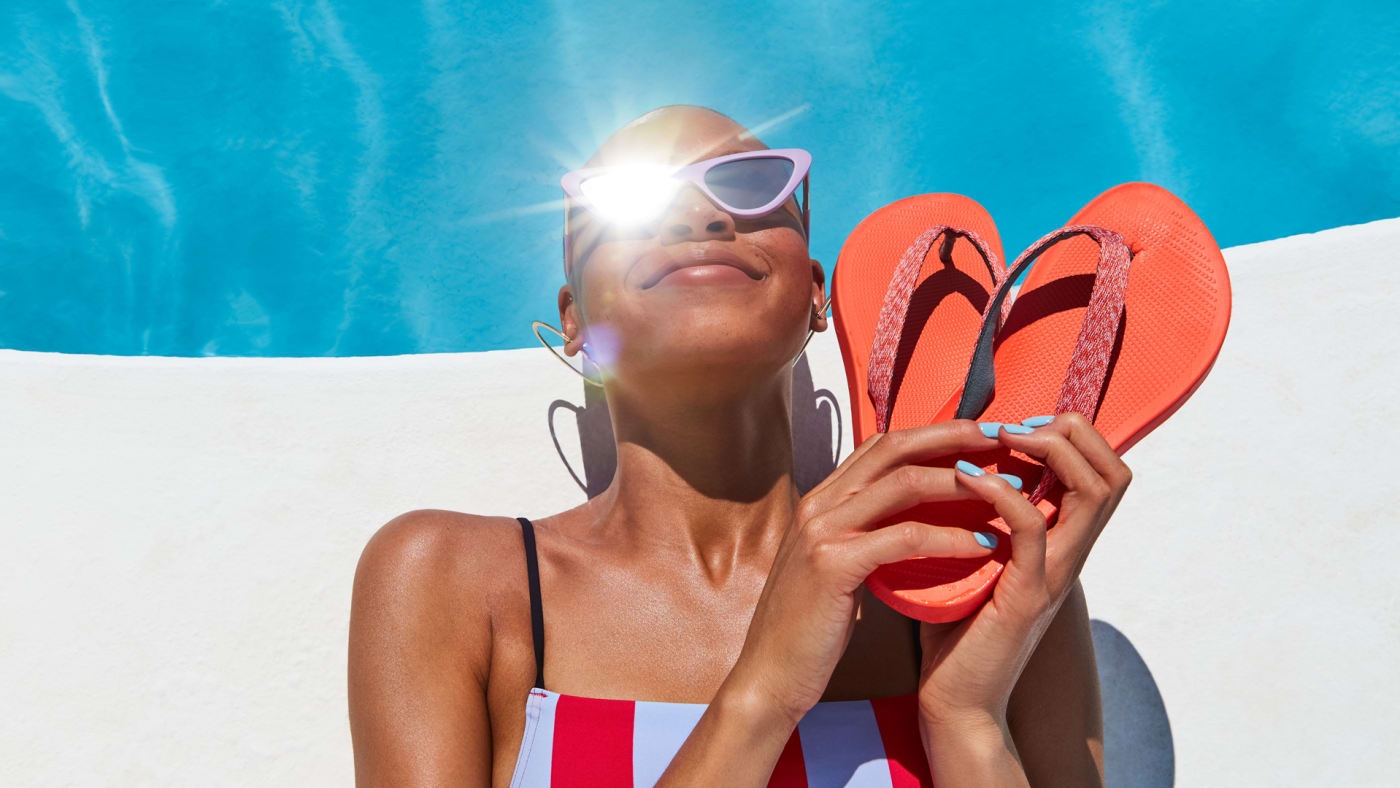Allbirds wants to fix your sole
Allbirds‘ newest product, a flip-flop, is deceptively simple.
The two-year-old startup–which took Silicon Valley by storm with its wool sneakers–is now releasing a sandal made from a piece of squishy, lightweight foam. The base softly cradles your foot when you slip it on, and a polyester strap with a microsuede lining sits snugly between your toes. There’s no doubt it’s a comfortable piece of footwear. Still, to the untrained eye, it looks like any other flip-flop on the market.
It’s not.
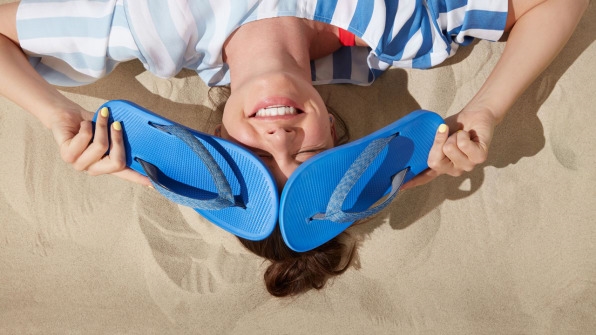
With these new flip-flops, Allbirds is showcasing a groundbreaking new material, called SweetFoam, which it has spent more than three years developing. The vast majority of shoes churned out by the $246 billion global footwear industry contains some form of EVA–a foam with a rubbery texture–in their soles. Until now, this material has been made with petroleum. But Allbirds has quietly invented a more sustainable version of it, creating the exact same EVA polymer using a renewable energy source–the sugar plant–instead of fossil fuel.
“Sugarcane pulls carbon out of the environment,” says Jad Finck, Allbirds’ VP of sustainability and innovation. “It breathes it in, converts it into chemical energy in the form of sugar, and then we convert it into this foam. So while other soles are adding to the carbon footprint, this one is actually carbon negative.”
But when it comes to sustainability, nothing is straightforward. The damaging impact of fossil fuels on the environment is well-documented, and the overproduction of sugarcane also causes serious harm to wildlife, soil, air, and water. Allbirds, which is a Certified B Corporation, says it is ensuring that all the sugar used to manufacture Sweetfoam has been certified by Proforest, a nonprofit, third-party verification system that validates that the raw material is sourced using stringent protective practices. The sugarcane is sourced from a region of Brazil where natural conditions, like heavy seasonal rainfall, are optimal for harvesting sugar, and during the Sweetfoam manufacturing process, sugarcane byproducts are used to power the mill and reduce inorganic fertilizer use. Similar concerns have come up with wool, which is why Allbirds works with ZQ Merino, an organization that ensures that wool is sourced from sustainable family farms that ensure the humane treatment of the animals.
Allbirds will incorporate SweetFoam into its product line of shoes, but the new flip-flop, dubbed the Sugar Zeffer, is mean to officially introduce it to the world–giving customers the opportunity to experience the new technology in a tangible way, feeling the foam right up against their skin. “If you want to highlight the sole, well, here’s a shoe that is entirely a sole,” says Lisa Halbower-Fenton, Allbirds’ head of product development, who helped design the flip-flop.
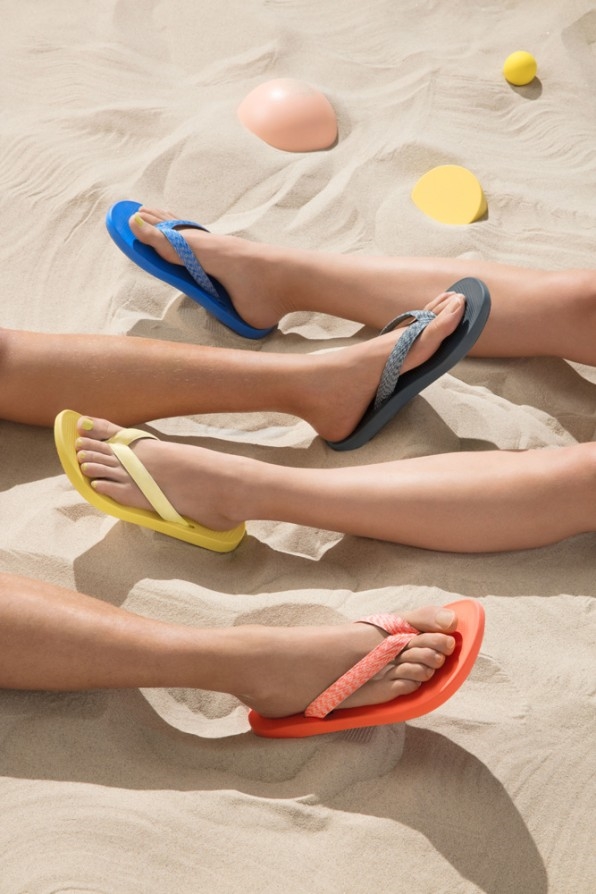
SweetFoam feels exactly the same as regular EVA foam, and the entire molecular structure of the foam is identical. The only difference is that it is derived from a plant. In fact, that’s the whole point: Allbirds is making the case that it is possible to make sustainable footwear that is virtually identical to what we are already wearing on our feet.
Perhaps more importantly, Allbirds is making the recipe for SweetFoam open-sourced and available to the rest of the industry so that other brands can start incorporating it into their shoes as well. Swapping out a carbon positive raw material with a carbon negative one could have an enormous impact on the industry: MIT scientists have found that a single pair of running shoes generates 30 pounds of carbon dioxide emissions, an unusually high amount for a product that does not use electricity, and 32% of this comes directly from the materials used.
“The beautiful thing is that it doesn’t require companies to change the way they make EVA, it just requires them to change what they buy to put in the machines,” says Finck. “Our goal was to innovate and show the industry that this could be done. But if this is actually going to take hold and have an impact, it is critical for this to scale beyond ourselves.”

RELATED VIDEO: Allbirds Has Made Wool Cool–And It’s Shaking Up The Footwear Industry
Sugar Dreams
Allbirds’ founders, Tim Brown and Joey Zwillinger, have been dreaming about sugar-based foam since before they officially launched the brand in 2016.
But reformulating EVA was an ambitious project, and the petrochemical corporations equipped to do it wouldn’t work with a scrappy little startup. So for the last two years, Brown and Zwillinger have been single-mindedly focused on building a healthy business and reaching the kind of scale that would allow them to have a real impact on the industry.
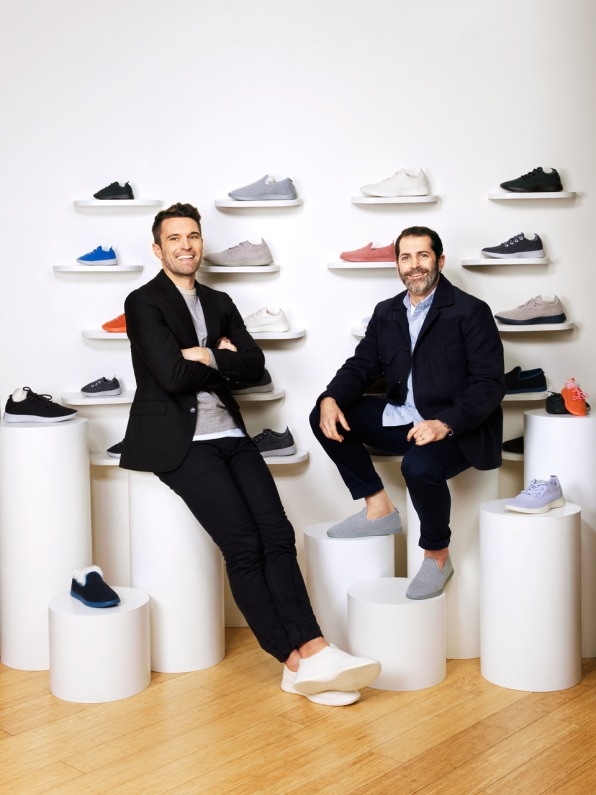
The pair met through their wives, who were college roommates at Dartmouth. Back in 2013, they each happened to be at a point in their careers where they were looking for a new direction, preferably something that gave them deeper meaning. Brown had recently retired from playing soccer professionally in New Zealand. He had observed the massive scale of the footwear industry firsthand through the hundreds of shoes athletic brands handed him in sponsorship agreements. Growing up in New Zealand, where there are 20 sheep for every human, Brown understood wool was an abundant and renewable resource and wondered why nobody had thought to use wool as the upper for a shoe. In his spare time, he began to tinker with a prototype of a more sustainable shoe.
Meanwhile, Zwillinger was an executive at a renewable energy company called Solazyme that was trying to replace petroleum with oil generated by fermented algae. But it was an industrial company, and Zwillinger wanted to be part of a business that brought sustainable products directly to customers. The duo hit it off instantly, and soon decided to partner on a sustainable shoe business. They were not particularly interested in running a fashion brand; they were far more interested in bringing material innovation to the shoe industry.
Nonetheless, Allbirds became a viral fashion phenomenon after launching with a $95 wool sneaker that was quickly followed by a loafer. The brand’s shoes have a minimalistic aesthetic with a soft, fuzzy upper that comes in a myriad of colors and a comfortable, supportive footbed. It is an irresistible combination in a post-athleisure world, where people are dressing more casually and prioritizing comfort.
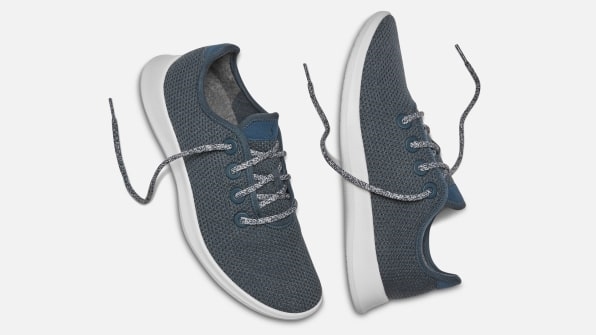
Within two years, the brand has sold a million pairs of the wool shoes and rolled out a summer version, called the Tree Shoe, made from eucalyptus fibers. (These were the first-ever shoes certified by the Forest Stewardship Council, which generally puts its stamp on paper products.) Allbirds already ships to New Zealand, Australia, and Canada, and Zwillinger says it plans to enter the Asian market soon. The company recently snagged a round of Series B funding, bringing its total investment to $27.5 million, which will help accelerate this expansion.
While the shoes come in traditional silhouettes, the unusual texture of their exterior makes them stand out. Step into any major U.S. city–New York, Los Angeles, Boston–and you’ll spot someone in these simple but unique-looking shoes. The tech community is obsessed with them, but they’re also popular with fashion-forward celebrities like Mila Kunis and Jennifer Garner.
Nowhere is the popularity of the shoe more apparent than in Allbird’s hometown, San Francisco. On a cool July day, I took a 10-minute walk from the Allbirds headquarters to the Ferry Building and spotted at least five people in multicolored Allbirds sneakers. When I bumped into a another tech journalist at Blue Bottle Coffee, he was sporting a pair of Tree Shoes.
Quiet sustainability
Today, Allbird’s headquarters buzzes with more than 110 employees, an exponential increase from the five people who helped launch the company. As Allbirds grows, it is quickly taking up more floors in its Financial District offices. On the day of my visit, New Zealand artist Toby Morris was painting an enormous mural on the staircase. Morris is responsible for the cute illustrations of sheep, birds, and shoelaces that adorn the Allbirds shoe boxes and website, and he is bringing this aesthetic directly into Allbirds HQ. Art is a big part of the company culture; the first thing you see when you enter the building are two floor-to-ceiling art installations inspired by the texture of the wool and tree shoes.
Around the office, employees model the many ways the shoes can be styled. There are millennials going for a normcore look with sneakers that are all black or all white. A stylish gen-Zer wears her gray pair with skinny jeans and a tunic top. And there are many others wearing the Bay Area techie uniform that consists of a simple T-shirt, jeans, and Allbirds paired with colorful socks.
I sat down with Allbirds’ founders at a conference table made from an enormous slab of reclaimed wood that Zwillinger had acquired and sanded down with a couple of employees. Zwillinger and Brown explain that while they never intended to create a trendy shoe, they realized they would not gain traction if they simply emphasized the sustainable nature of their brand. They needed to win customers over with comfort and style. “Our goal is product first,” Brown tells me. “If we’re going to change the way people live, we don’t want it to be because we’re guilting them into it or being overly earnest prescriptive.”
Zwillinger’s theory is that although consumers support sustainability as a concept, most don’t buy a product just because it’s better for the environment. But once that customer owns that product and its novelty has begun to wear off, the values of the brand begin to become more important. “Of our three pillars of comfort, design, and sustainability, the last one is meant to be the quieter one,” he says. “It doesn’t necessarily drive the initial purchase decision, but we feel like it keeps you in the family because you feel good about being associated with a brand that is working hard to do the right things.”
25 Billion Shoes
By 2018, Allbirds had sold 1 million shoes, and the business was continuing to grow explosively. Yet for all the material innovation that went into its uppers, the soles of the shoes were still weighing Brown and Zwillinger down. It seemed like the missing piece in an otherwise totally sustainable product.
It wasn’t just the soles of Allbirds shoes that troubled them. It was the fact that an estimated 25 billion shoes will flood the market this year, most of them made with petroleum-based foam. A simple switch to a renewable material in the manufacturing process had the potential to transform the industry. “The fact is that it is possible to come up with a more sustainable version of EVA, but shoe companies simply did not care enough to try to come up with it,” Zwillinger says. But it took an innovative shoe startup like Allbirds–which is minuscule compared to the scale of Nike or Adidas–to come up with a better way to make soles.
With his experience in the renewable energy industry, Zwillinger was already familiar with a Brazilian petrochemical company called Braskem, which had the ability to swap out sugar for petroleum in EVA manufacturing. After many trips to Brazil, the founders eventually convinced Braskem to partner with Allbirds, and SweetFoam was born. As it turned out, it wasn’t so hard or difficult to swap out the raw materials that went into the foam, making it all the more aggravating that nobody had done it yet.
While SweetFoam itself is Allbirds’ proprietary blend, the company chose–along with Braskem–to make the formula for the sugar-based EVA open-sourced. This is a big deal in the sneaker industry, where material formulations are valuable and most companies hold on to them very tightly. But thanks to Allbirds’ approach, any company that uses EVA in its products–from shoes to cars to helmets–can go directly to Braskem to ask for the recipe. “The core technology within SweetFoam is something that everyone is going to be able to use,” Finck says.
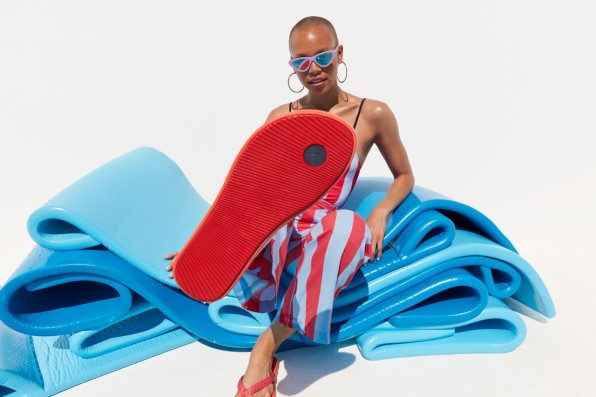
For Brown and Zwillinger, this is not just another fun new material it is bringing to the market: It’s the final component necessary to engineer an entirely eco-friendly shoe. It’s now just a matter of incorporating the SweetFoam into its current designs. “We started with Wool, we pulled off Tree, then our dream project was to swing to the fence for a home run by adding Sugar,” said Zwillinger. “Doing this would allow us to create this platform where we have reinvented every major piece of the shoe with more sustainable materials.”
Soon, all Allbirds shoes will have SweetFoam in their soles–distinguished from regular EVA foam by an imprinted pattern of little candies floating in the air. But until the full roll-out happens, Allbirds fans can purchase the $35 Sugar Zeffer–and even a $15 pack of colored straps to customize them–to enjoy for the last few months of the summer. (Or the first few months, for customers in Australia and New Zealand.)
Of course, this being Allbirds, the design team made sure that every other part of the flip-flop is also made from either recycled or bio-based material: The strap is made from recycled polyester yarn and plant-based microsuede. And it is painstakingly designed so that you can snap out the strap and recycle both parts of the flip-flop, so none of it needs to end up in a landfill when you’re ready to throw it away.
Despite the immense technical work that went into developing it, Allbirds’ founders know that many customers will likely be more interested in the squishy way the sandal feels between their toes and their bright New Zealand-inspired colors. “The foam we’ve created feels soft and springy, free and bouncy,” Finck says. “We hope the customer cares about the sugar aspect of it. But we want them to love it whether they know about it or not.”
Fast Company , Read Full Story
(22)

